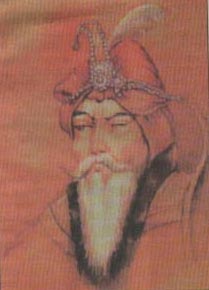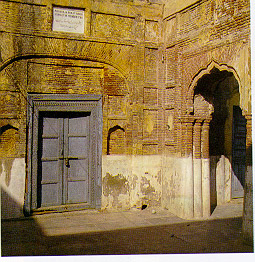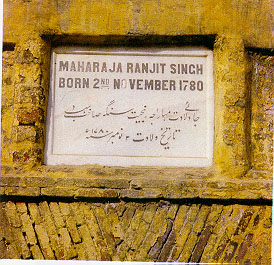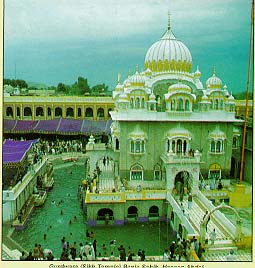Sikh Period
Sikh Period: 1762-1849 A.D.
The Sikhs established their Empire in the Punjab after the death of the Mughal Emperor Aurangzeb Alamgir in 1707. With the death of Aurangzeb the country saw a series of rapid governmental changes that stressed it in to the depths of anarchy. Taking advantage of this certain Charat Singh, who was the head of one of the Sikh Clans, established his stronghold in Gujranwala in 1763. Charat Singh died in 1774 and was succeeded by his son, Mahan Singh, who in turn fathered the most brilliant leader in the history of the Punjab: Maharaja Ranjit Singh. It was this remarkable leader who united the whole Punjab under one flag. His rule stretched from the banks of the Jamuna to the Khyber and from Kashmir to Multan. Maharaja Ranjit Singh was the most powerful of all the Sikh Rulers and ruled over for complete 40 years. After his death in 1840 the Sikh Empire was divided into small principalities looked after by several Sikh Jagirdars. This weak situation provided a good opportunity to the British of East India Company to put an end to the Sikh strong hold in the Punjab in 1849.
Sikhs are the followers of Baba Guru Nanak Sahib. He was the
son of Mehta Kalu Chand and Tripta Devi, both of them Khatris by caste. He was born
at Nankana Sahib in 1464. Sikhism was born as a direct reaction against rigid, cruel
and inhuman practices of Brahamanism and its rigid caste system. But another
important factor which influenced the mind of the people who contributed to the growth of
Sikhism, was the impact of Islam which had spread from Arabia to Iraq, Turkistan, Persia
and Afghanistan and came in to contact with Christianity, Judaism, Buddhism and
Zoroastrianism.
The Sikh religion is in fact a product of the Sufi and Bhakti school of thought.
Guru Nanak was greatly influenced by Kabir and Shaikh Ibrahim Farid (1450 - 1535) a
descendent of the famous Sufi saint Shaikh Fariduddin Shakarganj of Pak Pattan whose works
were incorporated in the Garanth Sahib. Guru Nanak studied books of Hindu and
Muslims religions and it was only after deep study of both the religions that he evolved
his own school of thought. The basic principles of the Sikhism are much closer to Islam
than to Hinduism. A study of the life, events of the Gurus and the large numbers of the
monuments sacred to them will, however, reveal how deeply all the Sikh Gurus in general
and Guru Nanak, Ajen Dev and Har Gobind Singh in particular are associated with Pakistan.

Emperor Ranjit Singh

Haveli, Rangit Singh Gujranwala

Birth Stone of Rangit Singh
Important Sikh Gurus |
Dates |
1. Guru Nanak Sahib |
(1464-1539 A.D) |
| 2. Guru Angad | (1504-1522 A.D) |
| 3. Guru Amar Das | (1509-1574 A.D) |
| 4. Guru Ram Das | (1534-1581 A.D) |
| 5. Guru Arjun Dev | (1563-1606 A.D) |
| 6. Guru Har Gobind | (1595-1645 A.D) |
| 7. Guru Har Rai | (1631-1661 A.D) |
| 8. Guru Har Krishan | (1656-1664 A.D) |
| 9. Guru Tegh Bahadur | (1622-1675 A.D) |
| 10. Guru Gobind Singh | (1665-1708 A.D) |
Smadhi Ranjit Singh
Sikh Shrines: The Gurdwaras are more than a place of
worship. They serve as Schools, meeting place and a rest house for the travelers in
addition to enshrining the Garanth Sahib. The Gurdwaras are, as such, integral part
of the Sikh religious and social life. Since the Sikh Rule lasted for almost a
century in the sub-continent there are hundreds of Gurdawaras all over Pakistan but mostly
in the Punjab, some of which are very famous such as Nankana Sahib and Punja Sahib. These
Gurdwaras are looked after by the Evacuee Trust Property Board (ETPB) which is under the
control of the Ministry of Culture, Islamabad.
The legacy of our predecessors at the time of our independence, on August 14, 1947, came to us as a treasure which may be called as Pakistan’s national heritage. So rich and diversified is this heritage that Pakistani nation can be proud of its glorious past, be Islamic, Post Islamic or pre-Islamic period as far back as pre-historic times. No other country of the world can produce the treasure of by gone days as can be found in Pakistan. It is now incumbent upon us to treasure our national heritage and save it from further deterioration and loss.

Punja Sahib, Hasanabdal
Cultural Heritage | History | Indus Civilization | Gandhara Civilization | Islamic Period | Sikh Period |
British Period Post Independence | Landscape| Gardens | Museums & Galleries Lahore 100 yrs ago |
| Home | |